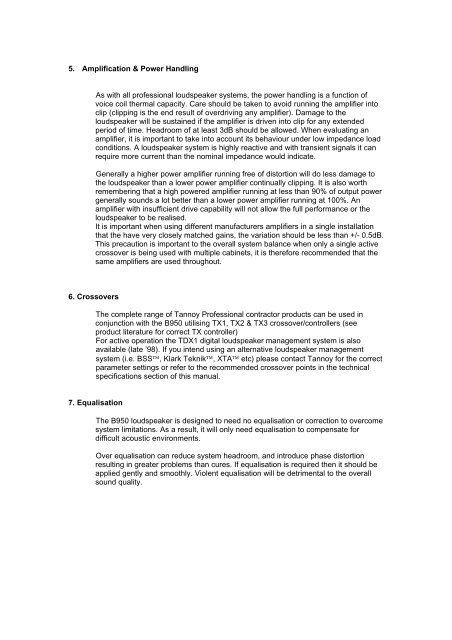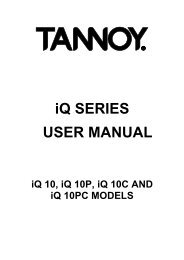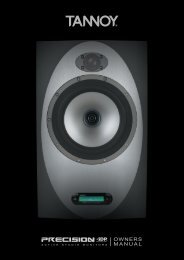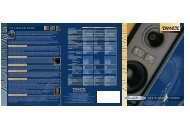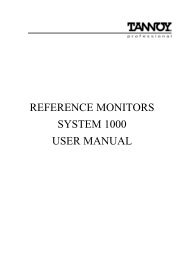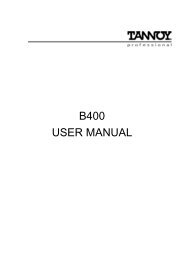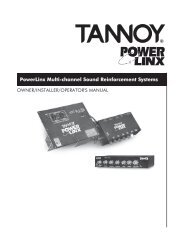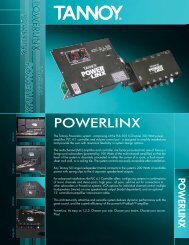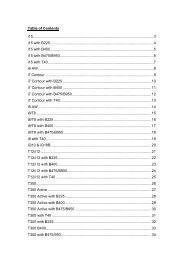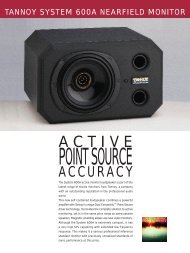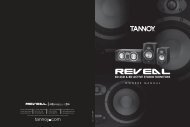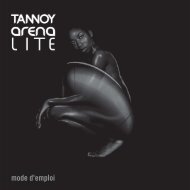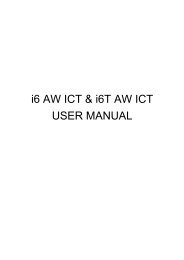B950 USER MANUAL - Tannoy
B950 USER MANUAL - Tannoy
B950 USER MANUAL - Tannoy
Create successful ePaper yourself
Turn your PDF publications into a flip-book with our unique Google optimized e-Paper software.
5. Amplification & Power Handling<br />
As with all professional loudspeaker systems, the power handling is a function of<br />
voice coil thermal capacity. Care should be taken to avoid running the amplifier into<br />
clip (clipping is the end result of overdriving any amplifier). Damage to the<br />
loudspeaker will be sustained if the amplifier is driven into clip for any extended<br />
period of time. Headroom of at least 3dB should be allowed. When evaluating an<br />
amplifier, it is important to take into account its behaviour under low impedance load<br />
conditions. A loudspeaker system is highly reactive and with transient signals it can<br />
require more current than the nominal impedance would indicate.<br />
Generally a higher power amplifier running free of distortion will do less damage to<br />
the loudspeaker than a lower power amplifier continually clipping. It is also worth<br />
remembering that a high powered amplifier running at less than 90% of output power<br />
generally sounds a lot better than a lower power amplifier running at 100%. An<br />
amplifier with insufficient drive capability will not allow the full performance or the<br />
loudspeaker to be realised.<br />
It is important when using different manufacturers amplifiers in a single installation<br />
that the have very closely matched gains, the variation should be less than +/- 0.5dB.<br />
This precaution is important to the overall system balance when only a single active<br />
crossover is being used with multiple cabinets, it is therefore recommended that the<br />
same amplifiers are used throughout.<br />
6. Crossovers<br />
The complete range of <strong>Tannoy</strong> Professional contractor products can be used in<br />
conjunction with the <strong>B950</strong> utilising TX1, TX2 & TX3 crossover/controllers (see<br />
product literature for correct TX controller)<br />
For active operation the TDX1 digital loudspeaker management system is also<br />
available (late ’98). If you intend using an alternative loudspeaker management<br />
system (i.e. BSS, Klark Teknik, XTA etc) please contact <strong>Tannoy</strong> for the correct<br />
parameter settings or refer to the recommended crossover points in the technical<br />
specifications section of this manual.<br />
7. Equalisation<br />
The <strong>B950</strong> loudspeaker is designed to need no equalisation or correction to overcome<br />
system limitations. As a result, it will only need equalisation to compensate for<br />
difficult acoustic environments.<br />
Over equalisation can reduce system headroom, and introduce phase distortion<br />
resulting in greater problems than cures. If equalisation is required then it should be<br />
applied gently and smoothly. Violent equalisation will be detrimental to the overall<br />
sound quality.


